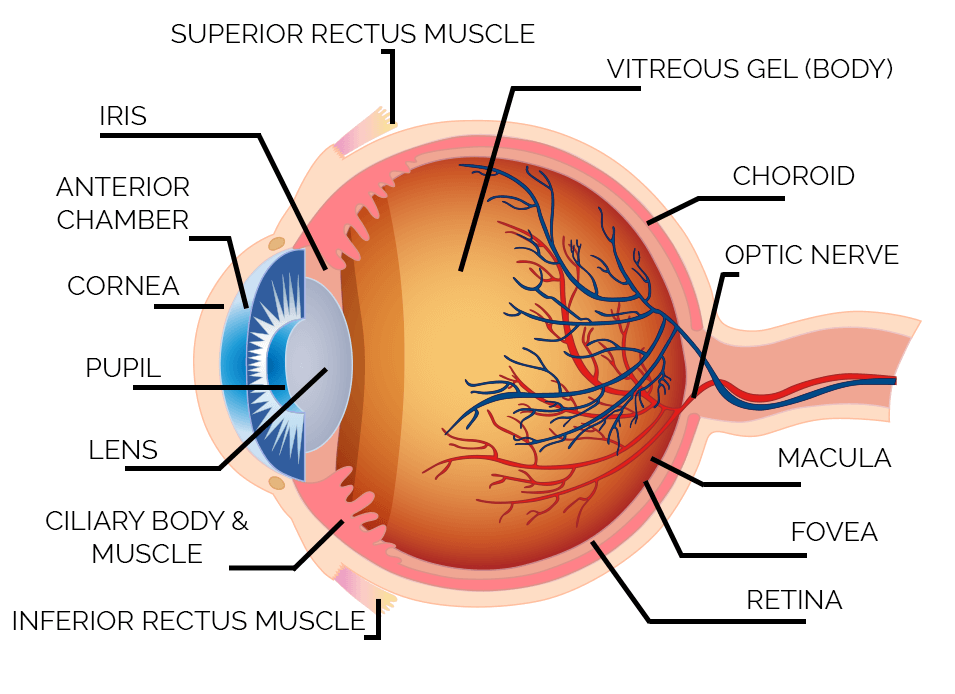How Your Eyes Work
The human body is amazing in itself, just even more so when we look at the parts that make up our whole. Take our vision for instance. Did you know that your eyes use 65% of your brainpower? That is more than any other part of your body. Eyes also have the ability to see a candle from 14 miles away. It is easy to take our eyes for granted, but have you ever wondered how your eyes work?

In the simplest terms, eyesight is the light reflecting off objects. That light enters the eye and travels instantly through the sections of the eye and is read by the brain. Hence, you see the object. Below is a breakdown of all the components of the eye and their functions.
Iris
The iris is responsible for controlling the size of the pupil. This means it also controls the amount of light that reaches the retina. Eye color also comes from the iris, which is commonly brown, hazel, green, gray, or blue.
Anterior Chamber
This space is filled with a fluid-like substance called aqueous humour. It is between the lens and the cornea. In addition to providing nutrition for the central cornea and lens, it maintains the pressure needed to inflate the eye.
Cornea
The cornea is transparent and located at the front of the eye. It begins focusing the incoming light by refracting or bending the rays that pass through the pupil.
Pupil
The pupil determines the amount of light that comes into the eye. Light comes through the pupil and then through the lens. Even though the pupil seems to be opening and closing (dilating and constricting) that is controlled by the iris.
Lens
Once light passes through the pupil, it enters the lens. The lens can change its shape, therefore, fine-tuning the vision process.
Ciliary Body & Muscle
Ciliary muscles surround the lens. While the muscles hold the lens in place, consequently they play a significant role in vision. The ciliary muscles assist the eye with producing an image by helping bend the rays and focus them on the retina.
Superior / Inferior Rectus Muscles
There are actually more muscles than these, six in total. They help turn or rotate the eye in all directions. Specifically, the superior moves the eye upward, and the inferior moves the eye downward.
Vitreous Gel (Body)
The vitreous humor is a jelly-like tissue that fills the eye. After light passes through the lens, it travels through this tissue. Finally, landing on the sensitive layer of cells called the retina.
Choroid
This is a vascular layer that is between the retina and the sclera (the white part of the eye). This is a very thin layer that provides oxygen to the outer layers of the retina. If you have ever taken a picture of someone and they seemingly have red eyes, this is the reflection of light from the choroid.
Optic Nerve
Also known as the cranial nerve II, is the part of the eye that transmits all our visual information – brightness, color, contrast – to our brain. It is located in the back of the eye and consists of more than one million nerve fibers.
Macula
Near the center of the retina, this part of the eye specializes in high-acuity vision. More specifically, the clarity of your vision. It also absorbs excess blue and ultraviolet light, acting as a sort of sunscreen for that area of your retina.
Fovea
Coming from the Latin word meaning pit, this is a central put made up of closely packed cones in your eye. It is in the center of the macula. This allows for sharp vision. These cone cells primarily interpret red and green light.
Retina
The retina is located in the back. It is a thin layer of tissue that contains millions of tiny light-sensing nerve cells. These nerve cells are called rods and cones because of their distinct shapes. The retina is the innermost layer that makes up your eye.
Rods
There are millions of these light-sensitive cells in the retina. Rods are used for monochromatic vision and help detect motion in dim light situations, or at night. They also provide our peripheral vision.
Ok, So Then, How Does Your Eye Work?
All of these components of your eye work together to transmit 10 million bits of information to your brain every second. The images are also sent to your brain backward and upside down, and translated there. Even with a diagram, there are many other components that make up the eye and therefore many things that can go wrong. If you have questions about how your eyes work or issues you may be experiencing with your eyesight, contact us today.
Share
